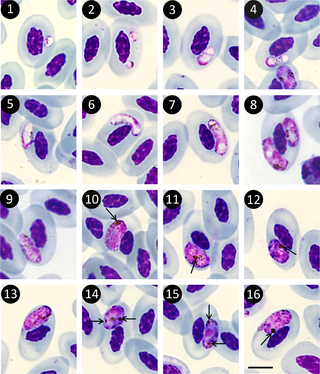
The turkey is a large bird in the genus Meleagris, native to North America. There are two extant turkey species: the wild turkey of eastern and central North America and the ocellated turkey of the Yucatán Peninsula in Mexico. Males of both turkey species have a distinctive fleshy wattle, called a snood, that hangs from the top of the beak. They are among the largest birds in their ranges. As with many large ground-feeding birds, the male is bigger and much more colorful than the female.

Plasmodium is a genus of unicellular eukaryotes that are obligate parasites of vertebrates and insects. The life cycles of Plasmodium species involve development in a blood-feeding insect host which then injects parasites into a vertebrate host during a blood meal. Parasites grow within a vertebrate body tissue before entering the bloodstream to infect red blood cells. The ensuing destruction of host red blood cells can result in malaria. During this infection, some parasites are picked up by a blood-feeding insect, continuing the life cycle.

Microsporidia are a group of spore-forming unicellular parasites. These spores contain an extrusion apparatus that has a coiled polar tube ending in an anchoring disc at the apical part of the spore. They were once considered protozoans or protists, but are now known to be fungi, or a sister group to fungi. These fungal microbes are obligate eukaryotic parasites that use a unique mechanism to infect host cells. They have recently been discovered in a 2017 Cornell study to infect Coleoptera on a large scale. So far, about 1500 of the probably more than one million species are named. Microsporidia are restricted to animal hosts, and all major groups of animals host microsporidia. Most infect insects, but they are also responsible for common diseases of crustaceans and fish. The named species of microsporidia usually infect one host species or a group of closely related taxa. Approximately 10 percent of the species are parasites of vertebrates —several species, most of which are opportunistic, can infect humans, in whom they can cause microsporidiosis.
Plasmodium azurophilum is a species of the genus Plasmodium. Like all species in this genus it is a parasite of both vertebrates and insects. The vertebrate hosts are anole lizards.
Plasmodium balli is a parasite of the genus Plasmodium.
Plasmodium dominicana is an extinct parasite of the genus Plasmodium.
Plasmodium fairchildi is a parasite of the genus Plasmodium.
Plasmodium sasai is a parasite of the genus Plasmodium subgenus Sauramoeba.
Plasmodium relictum is a species in the genus Plasmodium, subgenus Haemamoeba.
Plasmodium durae is a parasite of the genus Plasmodium subgenus Giovannolaia.
Plasmodium fallax is a parasite of the genus Plasmodium subgenus Giovannolaia.
Plasmodium wenyoni is a parasite of the genus Plasmodium. As in all Plasmodium species, P. wenyoni has both vertebrate and insect hosts. The vertebrate hosts for this parasite are reptiles.
Turkeypox virus is a virus of the family Poxviridae and the genus Avipoxvirus that causes turkeypox. It is one of the most common diseases in the wild turkey population. Turkeypox, like all avipoxviruses, is transmitted either through skin contact or by arthropods acting as mechanical vectors.
Plasmodium forresteri is a parasite of the genus Plasmodium.

Haemoproteus is a genus of alveolates that are parasitic in birds, reptiles, and amphibians. Its name is derived from Greek: haima 'blood' and Proteus, a sea god that had the power to assume various shapes. The name Haemoproteus was first used in the description of H. columbae in the blood of the pigeon Columba livia by Walther Kruse in 1890. This was also the first description of this genus. Two other genera—Halteridium and Simondia—are now considered to be synonyms of Haemoproteus.
Plasmodium juxtanucleare is a species of parasite in the family Plasmodiidae. The vertebrate hosts for this parasite are birds.

The Haemosporida are an order of intraerythrocytic parasitic alveolates.
Plasmodium circumflexum is a parasite of the genus Plasmodium subgenus Giovannolaia.
Plasmodium tejerai is a parasite of the genus Plasmodium subgenus Haemamoeba.




